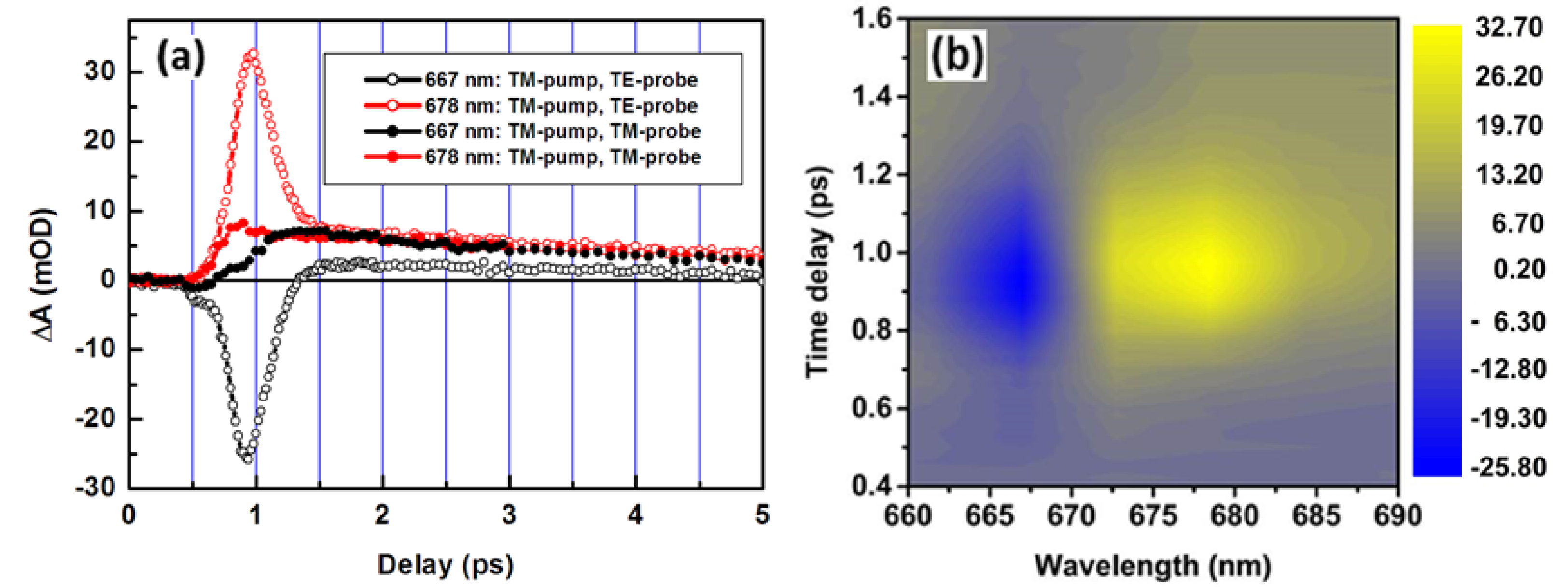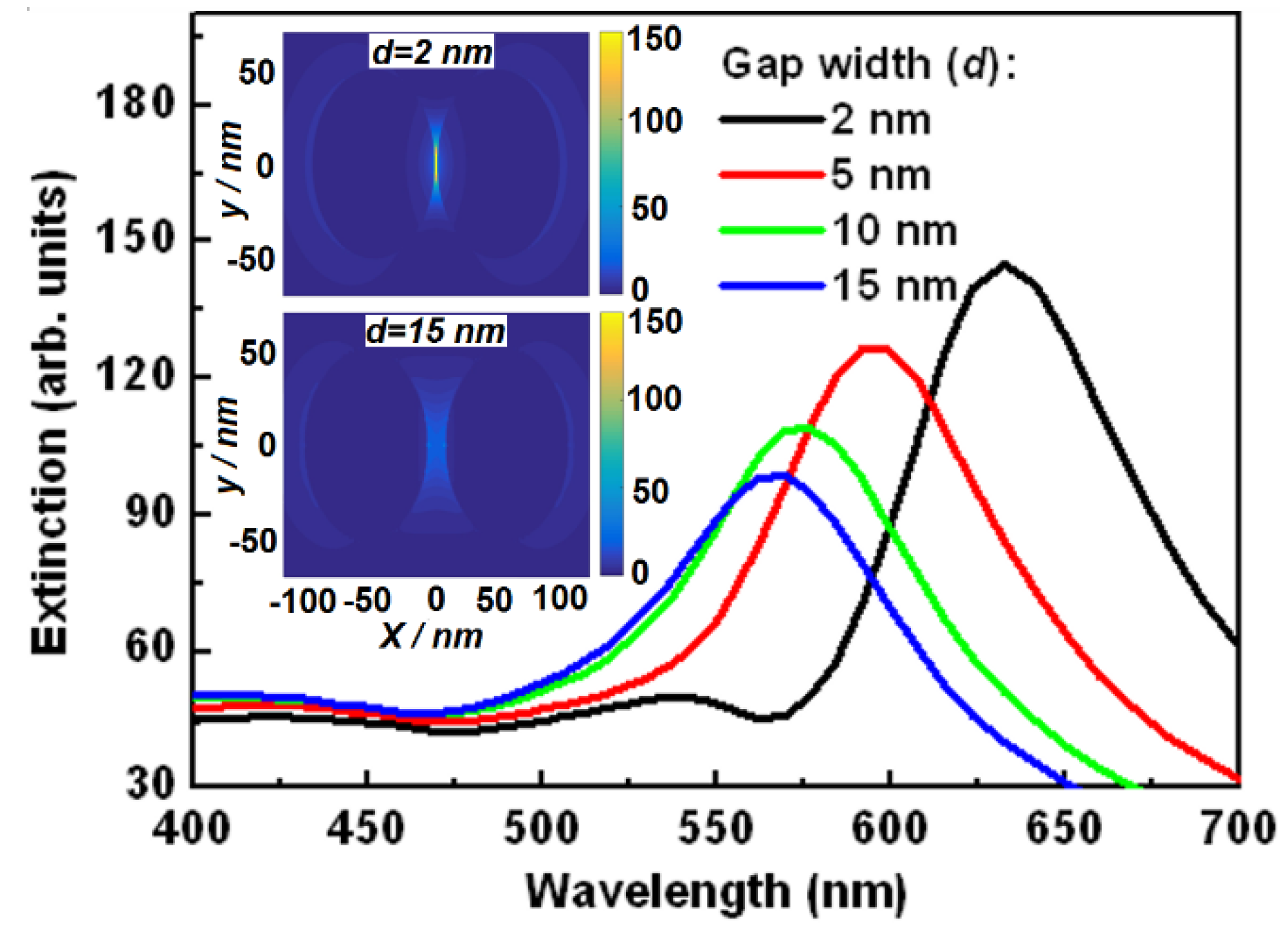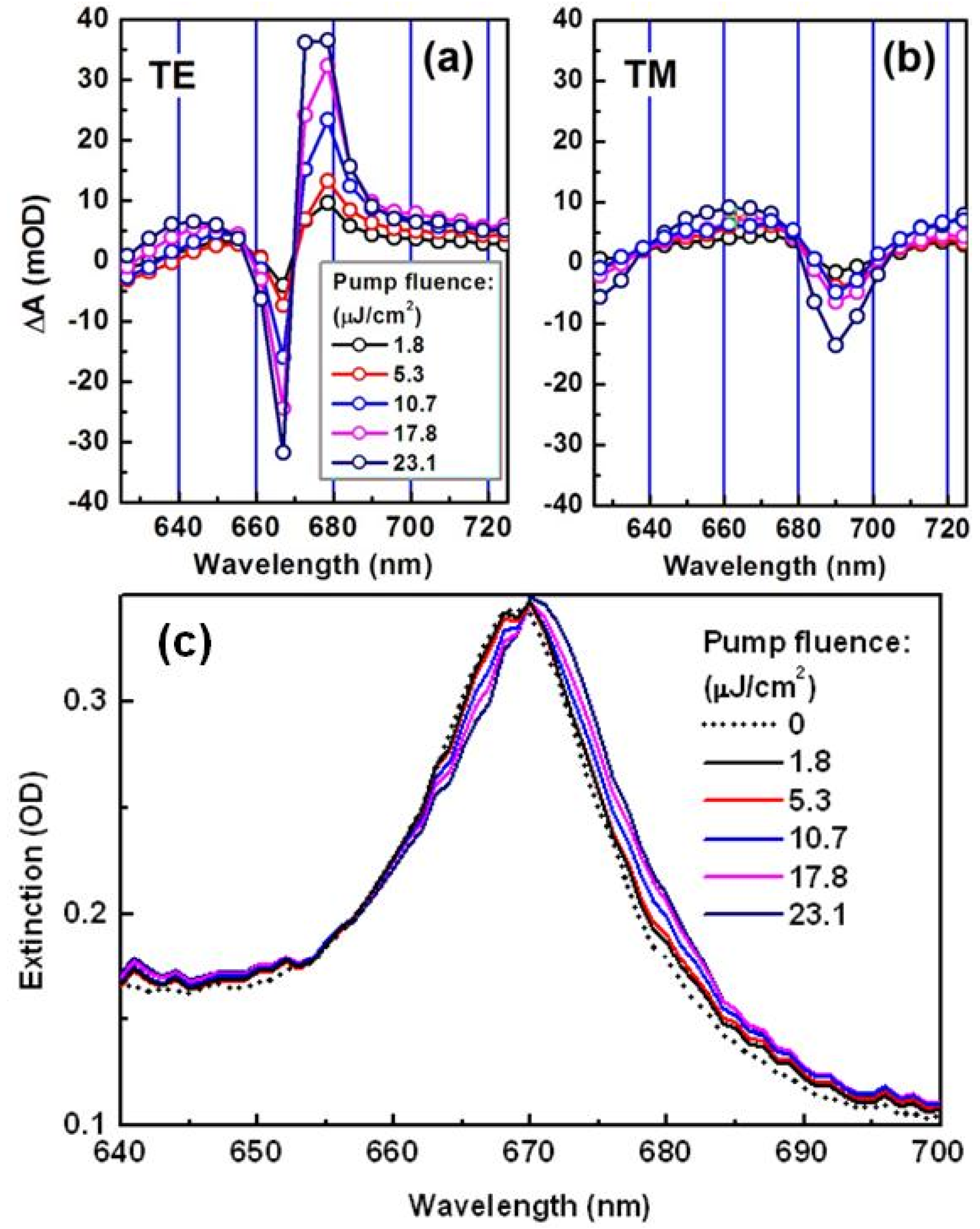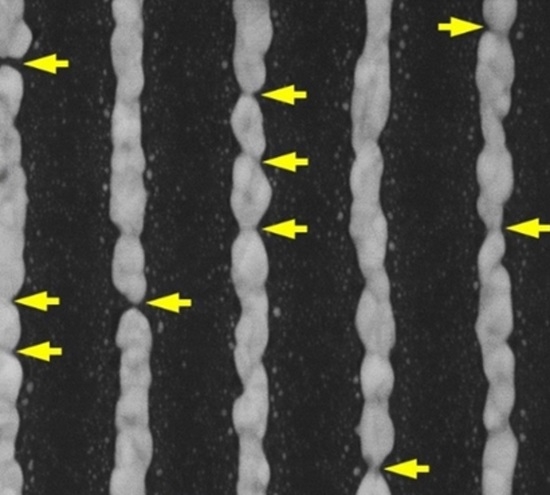3.1. Measurement Results of the Optical Switching Processes
The optical switching effect of the gold nanowires shown in
Figure 2a was investigated using femtosecond pump-probe measurements. A Ti: sapphire amplifier Legend Elite from Coherent provides 150 fs pulses at 800 nm with a repetition rate of 1 kHz and a maximum pulse energy of 1 mJ. These 800-nm pulses were used as the pump after some part of the pulse energy was sent to a 1-cm cell containing D
2O for supercontinuum generation. The supercontinuum pulse was used as the probe, which extends from sub-300-nm to longer than 1200 nm in spectrum. The delay between the pump and probe pulses was adjusted by a linear stage in the beam path of the pump pulse. The transient absorption (TA) spectrum was collected by the fiber spectrometer using CCD as the detection unit as a function of time delay.
According to
Figure 1b,c, the optical extinction at normal incidence is about 0.22 and 0.08 OD at 800 nm for TM and TE polarization, respectively. Therefore, stronger interaction between the gold nanowires and the femtosecond pump laser pulses may be achieved for TM than for TE polarization. Based on this consideration, TM polarization was employed for the 800-nm pump pulses. Thus, we present experimental results for two pump-probe schemes, where the pump pulses were TM polarized and the probe were TM and TE polarized, respectively. A pump fluence of 17.8 µJ/cm
2 was employed in the following demonstrated experimental results. Transient absorption was evaluated by ΔA = −log
10(T
on/T
off), where T
on and T
off are the transmission rate of the probe pulse through the sample with the pump pulse switched on and off, respectively.
Figure 2a shows the pump-probe dynamics of the optical switching performance measured at two typical wavelengths of 667 (black curves) and 678 nm (red curves), where the open circles show TM-pump/TE-probe and the solid ones show TM-pump/TM-probe measurement results. The pump beam was sent to the sample at an angle of 2 degrees, and the probe beam was incident normal to the sample surface. For the TM-pump/TM-probe scheme, a much smaller optical switching signal with positive ΔA values both at 667 and 678 nm were observed, as compared with that for TM-pump/TE probe. However, a strong negative signal within the first 1 ps of the time delay after the onset of the pump pulse was measured at 667 nm, and a strong positive signal was measured at 678 nm for the TM-pump/TE-probe scheme. Furthermore, in TM-pump/TE-probe, a much faster optical switching process than in the TM-pump/TM-probe scheme can be observed within the first 500 fs after the finish of the pumping process, as can be measured by evaluating the falling and rising edges of the red and black open circles, respectively, which is followed by a much slower dynamics. This faster process can be attributed to plasmonic electron-dominated scattering process, and the slower tail can be identified as a phonon-dominated process. Looking back at the two curves by solid circles, we can find that both of the optical switching signals at 667 and 678 nm are dominated by the slow dynamics. Comparing the optical switching dynamics of the two pump-probe schemes by the amplitude, speed, and sign of the ΔA values, we can conclude that they correspond to different photophysical processes. For TE-polarized probe, we need to base our analysis on the black spectrum in
Figure 1b, where simple waveguide resonance mode without coupling with plasmon resonance can be observed. This is because the thermal effect-induced change in the cross-plasmon can be observed only when the sample is excited by the pump pulses. In this case, 667 and 678 nm fall into the rising and falling edges of the spectral peak in
Figure 1b, respectively. This is why a negative and a positive transient signal were observed at 667 and 678 nm, respectively, due to the optical excitation-induced redshift of the spectrum. However, for TM-polarized probe, we should use the black spectrum in
Figure 1c to understand the transient spectroscopic change in the Fano-coupling process. Due to the broad-band spectral feature and the location of both wavelengths at the bottom of the spectral dip, small positive transient signals were observed for TM-probing as optical excitation induced electron–electron and electron–phonon scattering, which led to the redshift of the LSPR spectrum.
Additionally, we need to note that the optical switching signal for TM-pump/TM-probe resulted from Fano coupling between the waveguide resonance mode and LSPR, while the wavelengths of 667 and 678 nm are located near the bottom of the coupling spectrum, as can be observed in the black spectrum in
Figure 1c. The optical excitation induced redshift of LSPR and led to a complicated modulation on the spectrum of the coupled mode, which is also dependent on the pulse intensity that is varying with the pulse shape. The rising edge of the spectrum corresponds to a negative transient spectrum and falling edge to a positive value. Due to the complicated process at the bottom of the spectral dip, the dynamics may involve superimposition of pulse-intensity dependent processes. This is why dynamics at 667 and 678 nm for TM polarization have different rising times.
Figure 2b shows a three-dimensional (3D) plot of the optical switching signal as a function of wavelength and time delay for the pump-probe scheme of TM-pump/TE-probe, which was measured at normal incidence of the probe beam. Negative TA spectra were measured at wavelength shorter than 672 nm, and positive ones were measured at wavelengths longer than 675 nm, which implies a red shift of the excited spectrum of plasmon resonance. Such a red shift took place within a spectral band as narrow as 20 nm, as shown in
Figure 2b. These observations enable us to find out the mechanisms for the much-enhanced optical switching signal in the TM-pump/TE-probe scheme.
3.2. Mechanisms for the Ultrafast-Heating Enhancement
Although the temperature dependence of dielectric permittivity of the host matrix may also contribute to the redshift of plasmon resonance [
17], such mechanisms should not have polarization dependence. In this work, we observed strong redshift of the spectrum for TE polarization in the direction of the grating lines. This is the basis for us to attribute the TA spectroscopic response to a cross-plasmon at the gaps between the gold nanostructures along the grating lines. Actually, thermal expansion effects for gold nanoparticles have been investigated [
18]. We made an evaluation of the thermal expansion amount of the gold nanostructures using parameters of gold: thermal expansion coefficient (α
L): 14 × 10
−6/°C; heat capacity (
CT): 128 J/kg·°C; and density (
): 19.3 g/cm
3. We also use the following parameters of the gold nanostructures in our pump-probe measurements: average volume of gold nanostructures along the grating lines (
V): 3.9 × 10
−15 cm
3; average length of the gold nano-segments (
L): 300 nm; and estimated average optical pulse energy absorbed by such a gold nanostructure (Δ
EO): 8 × 10
−13 J. Thus, if we assume homogeneous and linear thermal expansion of the gold nanostructures under optical-excitation heating, the expansion amount can be evaluated roughly by
. As a result, the thermal expansion of the gold nanostructures after excitation can be estimated to be 0.35 nm.
As has been reported, a kind of cross-plasmon may be induced if the gap between the plasmonic nanostructures is smaller than 20 nm [
19]. The resonance spectrum of such plasmons shifts to the red with reducing gap width.
Figure 3 shows a series of simulation results of optical extinction spectra of the gold nanoparticles when changing the separation distance or the gap width between them. In the simulation, we used finite-difference time-domain (FDTD) method, where the parameters of the gold nanoparticles were adopted from the Palik database and the calculation was performed in the spectral range from 400 to 700 nm. The light beam was assumed to be polarized along the co-axis of the two gold nanoparticles, and the gold nanoparticles were assumed to be immersed in air with an ITO glass substrate. The gold nanoparticles have the same diameter of 100 nm. The optical extinction spectrum was calculated at different separation distances (
d). As shown in
Figure 3, the optical extinction spectrum shifted from about 633 to 565 nm when
d was increased from 2 to 15 nm. Furthermore, the amplitude of the optical extinction spectrum was also reduced with increasing separation distances, corresponding to the reduction in the cross coupling between the gold nanoparticles. It can be understood that a sufficiently large separation between the gold nanoparticles corresponds to a system consisting of isolated gold nanoparticles, where the spectrum of plasmon resonance is a response of a single gold nanoparticle.
Excitation using femtosecond pulses has heated the electrons in the gold nanowires. Such a heating process led to thermal expansion of the nanostructures along the gold nanowires. However, red-shift of the resonance spectrum has verified a reduction process of the gap width between the gold nanostructures appearing as particles or segments.
3.3. Pump Fluence Dependence of the Ultrafast Optical Switching Effect
Figure 4a,b shows the measurement results on the pump fluence dependence of the transient spectrum for TE and TM polarization, respectively, where the pump fluence was increased from 1.8 to 23.1 µJ/cm
2. To demonstrate the large difference in the optical switching effect between TE and TM polarization, we have scaled the vertical axis using the same range of ΔA. We can observe a much larger amplitude of the TA spectrum for TE than for TM polarization in the spectral range from 625 to 725 nm, verifying our proposed mechanisms in this work. Narrow-band TA spectra with negative features on the left and positive on the right for TE polarization imply a red-shift of the resonance spectrum. However, for TM polarization, we observe a negative dip centered at about 690 nm with relatively broad-band positive spectra on both sides, indicating complicated transient processes involved in the excitation of the Fano resonance mode.
For both TE and TM polarization, we observed increased amplitude of the TA spectrum with increasing pump fluence, which is convincing evidence that higher pump fluence induced larger spectral shift of the plasmon resonance. For clearer observation of the red-shifted plasmon resonance, we rebuilt the spectra of the optically excited plasmon resonance by including the TA spectra into the steady-state optical extinction spectrum. Assuming that the optical extinction spectrum of the gold nanowires is described by A(λ) for TE polarization with A(λ) = −log
10T(λ) and the TA spectrum by ΔA(λ) in
mOD, where T(λ) is the transmission spectrum through the gold nanowires, the optical extinction spectrum of the optically excited plasmon can be written as: A
E(λ) = A(λ) + ΔA(λ)/1000.
Figure 4c shows the plots of A
E(λ) at pump fluence of 1.8, 5.3, 10.7, 17.8, and 23.1 µJ/cm
2. A(λ) was also plotted in
Figure 4c by the dotted curve for comparison. We can observe a red-shift of more than 2 nm when the pump fluence was increased from 0 to 23.1 µJ/cm
2. Thus, the results in
Figure 4 verified different plasmonic response for different polarizations, where the scheme of TM-pump/TE-probe has much higher efficiency than TM-pump/TM-probe, and higher pump fluence resulted in larger spectral shift of the cross-plasmon for TE polarization.
We may verify the agreement between our proposed mechanisms and the TA measurements by a comparison between the simulation results in
Section 3.2 and the experimental results in
Section 3.3. If we assume an approximately linear red-shift of the resonance spectrum with the reduction in the gap width, we can estimate a spectral shift of about (633 − 565)/(15 − 2) × 0.35 ≈ 1.8 nm, where we have used the thermal expansion amount of the gold nanostructures as large as 0.35 nm under optical excitation. The measured spectral shift using the rebuilt spectra in
Figure 4c is about 2.2 nm at the peaks and at the falling edges. However, such a difference justifies a rough agreement between the simulation and the measurement. The reasons for the deviation may be understood by considering the deviation of the dimmer spheres in the modeling from the practical plasmonic nano-segments in the sample.










